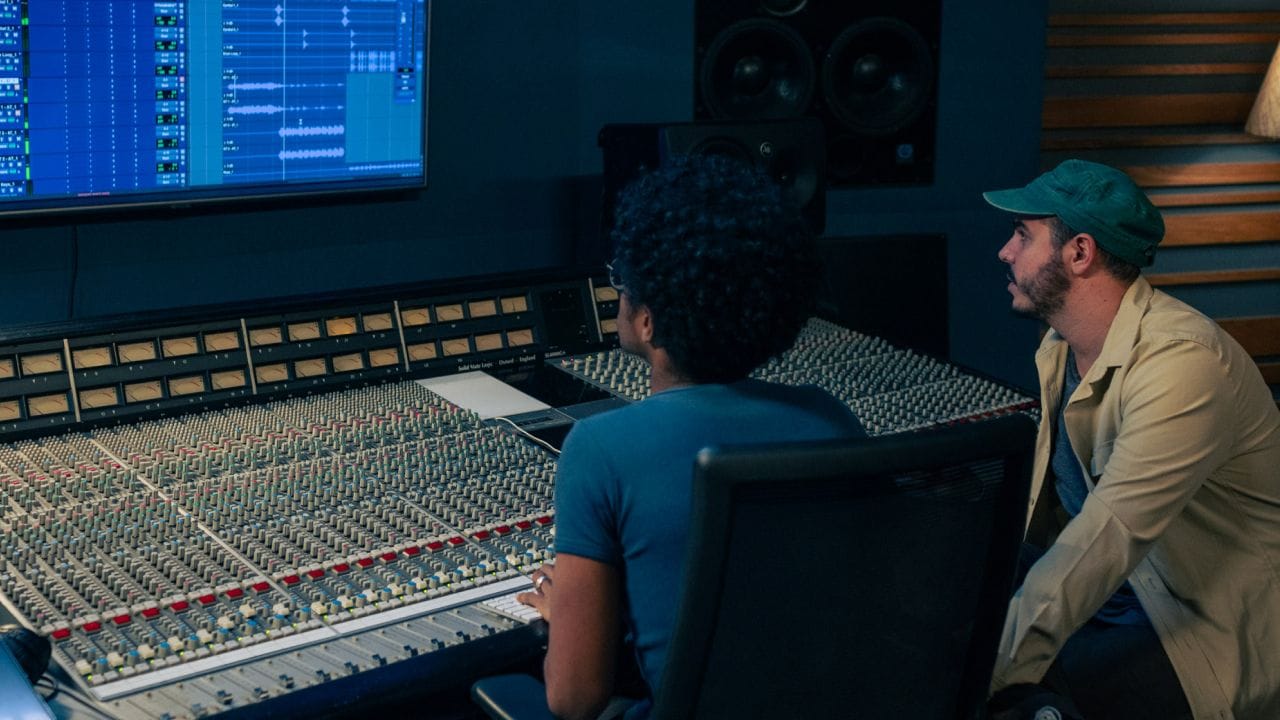chieving a professional sound in music production hinges on effective audio mastering. While traditional mastering has long been the gold standard, online mastering—often powered by AI—has gained traction for its accessibility and speed.
Let’s dive into the nuances of both approaches, exploring their processes, benefits, and how they shape your final master.
What is audio mastering?
Audio mastering is the final step in music production. It polishes your track, ensuring it sounds consistent and balanced across all playback systems—from high-end speakers to basic earbuds. Think of it as the finishing touch that gives your music a professional edge.
In this process, several techniques are used to refine the sound. The result? A track that is ready for distribution.
Here are some key aspects that mastering covers:
- Loudness: Mastering balances loudness with overall sound quality, using compression, limiting, and EQ to boost volume without losing clarity or dynamics;
- Equalization (EQ): This process shapes the track’s frequency response. Adjustments to bass, mids, and treble help enhance elements, correct imbalances, and achieve a balanced sound;
- Stereo imaging: Controls the placement of sounds within the stereo field. Adjustments to width, depth, and panning create a more immersive listening experience;
- Dynamics: Mastering also manages the track’s dynamic range, smoothing out peaks and valleys with compression and limiting for a more consistent sound;
- Noise reduction: Eliminates unwanted noise like hiss, hum, or clicks to enhance overall audio quality.
In essence, mastering is about refining the sound of a mix to make it ready for release and ensuring that it translates well across different listening environments. By carefully considering these aspects, mastering engineers can help to create a polished and professional-sounding final product.
What is the difference between mixing and mastering?
Mixing and mastering are often confused but serve distinct purposes. Mixing balances individual elements like vocals, instruments, and effects, creating a cohesive sound. Mastering polishes the mix, enhancing overall sound quality, volume, and consistency across all playback systems. If your mix isn’t ready, no mastering—online or traditional—can fully save it.
Traditional mastering: The classic approach
Traditional mastering is performed by skilled engineers who work closely with artists to bring their vision to life. Mastering engineers listen critically to the mixed audio, making precise adjustments to enhance clarity, balance, and depth.
These professionals use their trained ears and technical know-how to identify issues and elevate the audio quality. They adjust levels, apply compression, and enhance the stereo field, ensuring that the results meet industry standards.
Studio setup and equipment
Traditional mastering studios are designed for pristine audio reproduction. High-quality equipment like analog equalizers, compressors, and converters are used to shape the sound.
The controlled acoustic environment allows for precise adjustments, and engineers often work with high-resolution WAV files to maintain the integrity of the original recording.
Online mastering: A modern solution
Online mastering leverages technology to offer a faster, more budget-friendly alternative to traditional methods.
While there are online mastering services that connect artists with human engineers (similar to traditional mastering), online mastering also refers to services that rely on AI-driven tools to streamline the process.
AI mastering uses advanced algorithms trained on vast amounts of music data to analyze your track. It automatically adjusts equalization, compression, and stereo enhancement to create a balanced sound. Think of it as having a virtual mastering engineer who knows the best practices for a polished track.
Speed and affordability
Online mastering services provide quick results, often delivering mastered tracks within minutes or, at most, a few hours. This fast turnaround is ideal for independent artists, as well as producers on tight deadlines.
Moreover, the cost-effectiveness of online mastering (typically offered through subscription models or pay-as-you-go plans) makes professional-quality mastering accessible without breaking the bank.
Mastering with Moises
Moises takes online mastering to the next level with its AI-driven technology, designed to make your music sound polished and professional. By analyzing your track and applying intelligent adjustments, Moises ensures your music meets industry standards with minimal effort.
This process is built to suit everyone, from beginners looking for a simple solution to advanced users seeking more control.
Moises’ AI Mastering offers three modes, each tailored to different needs and levels of expertise:
- Auto Mode: Ideal for quick results, Auto Mode automates mastering by adjusting key elements like volume, EQ, and dynamic range, making it easy to achieve a balanced and professional sound without the need for manual tweaking.
- Advanced Mode: This mode is perfect for users who want more control over the mastering process. Advanced Mode provides options for fine-tuning parameters like target loudness, ceiling, and mastering intensity, allowing users to make precise adjustments to their audio.
- Reference Mode: Reference Mode matches the sonic qualities of your audio to a reference track, making it easy to achieve the desired sound. This is particularly useful when mastering cover songs or aiming to emulate the sound of a specific track.
In any task where AI may compete with human skill, there’s an irreplaceable human touch that algorithms cannot fully capture. That stands true for mastering as well.
Yet, online mastering with tools like Moises provides convenience and accessibility that traditional methods simply cannot match. It empowers artists to quickly and affordably polish their tracks without needing specialized equipment or extensive expertise—ideal for today’s fast-paced music industry.
Ultimately, choosing between traditional and online mastering comes down to your needs. For a personalized, hands-on approach, traditional mastering remains the gold standard. But if you’re after efficient, cost-effective results that still deliver professional sound, online mastering is a great fit.







